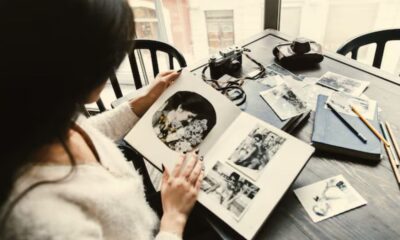FASHION
The Timeless Allure of Corseturi: A Journey Through Fashion History

and elegance, have evolved dramatically over centuries. From their early utilitarian beginnings to becoming iconic pieces that define eras, corseturi tell stories of societal norms, personal expression, and beauty ideals.
As we embark on this journey through time, we’ll explore how these alluring garments shaped women’s lives while reflecting cultural shifts and changing attitudes towards body image. Join us as we delve into the captivating world of corseturi—a blend of art, craftsmanship, and heritage that continues to inspire designers today.
The Evolution of Corseturi: From Ancient Times to the Victorian Era
Corseturi have a fascinating lineage that stretches back to ancient civilizations. The earliest forms can be traced to the Minoans around 2000 BC, where women wore fitted garments emphasizing their shapes.
As time progressed, the Greeks and Romans introduced more structured undergarments. These pieces were designed not just for aesthetics but also for support and modesty. However, it wasn’t until the Middle Ages that corsets began to take on their modern form.
The Renaissance saw an explosion of styles, with bodices becoming tighter and more elaborate. This period laid the groundwork for what would become a staple in women’s fashion: the tightly laced corset.
By the Victorian era, corseturi reached new heights of popularity and complexity. Women embraced exaggerated hourglass silhouettes as societal expectations dictated beauty standards focused heavily on waist size—an evolution deeply ingrained in fashion history.
The Golden Age of Corseturi: The 19th Century
The 19th century marked the pinnacle of corseturi fashion. Women’s silhouettes underwent a dramatic transformation as tight-lacing became synonymous with beauty and status. The hourglass figure reigned supreme, accentuated by intricate designs.
Corsets were more than just garments; they symbolized femininity and societal expectations. Elegant fabrics adorned with lace and embroidery elevated their allure. They were crafted not only for support but also to make bold statements about wealth and class.
Fashion trends shifted frequently, dictating corset styles that varied from simple shapes to elaborate structures featuring busks, boning, and even ruffles. This era celebrated the art of tailoring, where skilled artisans produced custom-fit pieces for the elite.
However, beneath this glamorous exterior lay discomfort. Many women endured physical constraints in pursuit of an idealized form, revealing complexities in their relationship with fashion during this golden age.
Breaking Free from Constrictions: The Rise of the Modern Corset
The modern corset signifies a pivotal shift in fashion. No longer a tool for rigid conformity, it has transformed into an emblem of empowerment and self-expression.
Today’s designs embrace comfort alongside style. They’re crafted from diverse materials that allow for movement while still highlighting the waist. This evolution means wearers can enjoy both aesthetics and practicality.
Fashion icons have embraced this change, sporting corsets as standalone pieces or layered under jackets and dresses. The versatility is striking; they can be bold statement items or subtle additions to an outfit.
Additionally, the rise of body positivity has played a crucial role. Modern corsetry celebrates all shapes and sizes, encouraging individuals to flaunt their figures confidently.
This renewed approach champions personal choice over societal expectations, allowing everyone to define their relationship with fashion on their own terms.
Controversies Surrounding Corseturi
Corseturi have long been a topic of heated debate. Their intricate design often symbolizes beauty, femininity, and allure. However, they also represent discomfort and societal pressure.
Critics argue that the corset promotes unrealistic body standards. Many women felt compelled to conform to an idealized silhouette, leading to physical health issues like restricted breathing or even organ displacement. This heavy criticism sparked discussions about body autonomy and self-image.
Conversely, some view corsets as empowering garments. They allowed wearers to shape their identities through fashion choices rather than mere trends dictated by society. In contemporary culture, this has led to a resurgence in corsetry that embraces both aesthetics and comfort.
The tension between tradition and modernity creates a fascinating dialogue around corseturi today. As designers experiment with materials and cuts, the conversation continues evolving alongside cultural perceptions of beauty and individuality.
Revival and Reinvention: Corseturi in Modern Fashion
Corseturi have made a surprising comeback in recent years, evolving far beyond their historical roots. Modern designers are experimenting with the silhouette, transforming traditional elements into chic pieces that blend comfort and style.
Streetwear brands now incorporate corset-inspired designs into casual outfits. These garments often feature softer materials and innovative cuts that prioritize wearability while retaining an alluring shape.
Fashion icons frequently showcase corsets on red carpets, pairing them with everything from tailored suits to flowing gowns. This versatility highlights how corsets can enhance various styles rather than confine them.
Additionally, many contemporary brands focus on inclusivity by offering diverse sizing options. This shift embraces all body types and encourages self-expression through fashion.
Social media plays a pivotal role in this revival as influencers share creative ways to style corseturi for everyday wear. The result is a fresh take on a classic piece that resonates with modern sensibilities while celebrating its rich history.
The Enduring Appeal of Corseturi: Why It Continues
Corseturi possess an enchanting quality that transcends time. Their ability to shape the body and highlight the waist creates a captivating silhouette, appealing to many fashion enthusiasts.
The versatility of corsets is another factor in their enduring charm. They can be styled with various outfits, from elegant gowns to casual streetwear. This adaptability makes them a staple in modern wardrobes.
Moreover, corseturi evoke nostalgia for bygone eras while simultaneously embracing contemporary trends. They serve as a bridge between past elegance and present-day innovation.
With growing movements toward body positivity, corsets have been reimagined to celebrate diverse shapes and sizes. Designers now offer inclusive options that cater to all bodies.
The allure of corseturi lies in their rich history intertwined with empowerment and self-expression. Wearing one often feels like donning a piece of art steeped in narrative and cultural significance.
Conclusion
Corseturi have woven themselves into the fabric of fashion history, captivating hearts and minds through centuries. From their ancient origins to their present-day interpretations, these garments tell a story of beauty, restraint, and rebellion.
The journey of corseturi reflects societal changes and shifting ideals. They symbolize not just an aesthetic choice but also the evolution of women’s roles in society. The allure they hold today is intertwined with nostalgia for bygone eras blended with modern twists that make them relevant now.
As we look to the future, corseturi will likely continue to spark interest among designers and fashion enthusiasts alike. Their rich history offers endless inspiration for creativity while inviting conversations about body image and personal expression.
Embracing this timeless piece can be a testament to both tradition and innovation. Corsets signify strength wrapped in elegance—a reminder that what may seem constrictive can also empower individuals on their unique style journeys.

FASHION
Transform Your Tresses: How Condish Healthy Hair Therapy Revives Damaged Locks

Introduction to Condish Healthy Hair Therapy
Are you tired of battling dry, damaged hair that refuses to cooperate? Do you dream of luscious locks that shine with health and vitality? If so, it’s time to discover the magic of Condish Healthy Hair Therapy. This innovative treatment is designed to breathe new life into your tresses, transforming them from lackluster to luminous. Packed with natural ingredients and backed by science, Condish promises not just a quick fix but a genuine revival for your hair. Say goodbye to frizz and split ends—your journey towards stunningly healthy hair starts here!
The Science Behind the Product: Key Ingredients and Benefits
Condish Healthy Hair Therapy harnesses the power of nature to restore and rejuvenate damaged hair. Its formula is packed with ingredients known for their nourishing properties.
Argan oil, rich in antioxidants, deeply hydrates while promoting shine. It works wonders on brittle strands, helping them regain elasticity.
Another star ingredient is keratin, a vital protein that strengthens hair structure. This helps reduce breakage and frizz, leaving your locks smooth and manageable.
Coconut oil adds an extra layer of moisture by penetrating the hair shaft effectively. This natural hydrator also protects against heat damage from styling tools.
Aloe vera soothes the scalp and promotes growth. With its anti-inflammatory qualities, it ensures a healthy environment for new hair to thrive.
Together these components create a holistic approach to repairing tired tresses. Each application transforms your mane into healthier strands you can proudly flaunt.
How to Use Condish for Optimal Results
To achieve the best results with Condish Healthy Hair Therapy, start with clean, damp hair. Gently wash your hair using a sulfate-free shampoo to remove dirt and oils.
Next, apply a generous amount of Condish directly onto your strands. Focus on the mid-lengths and ends, where damage is most prevalent. You don’t need to slather it on your roots; that can weigh down fine hair.
Take time to massage the product into your locks for better absorption. Leave it in for at least 5-10 minutes—longer if you desire deeper hydration.
For an extra boost, consider wrapping your hair in a warm towel or using a shower cap while waiting. The heat helps open up the cuticles for maximum penetration of nutrients.
Rinse thoroughly with cool water to seal those benefits in place and reveal smoother, healthier tresses afterward.
Success Stories: Real People, Real Results
Maria had struggled for years with brittle, lifeless hair. After just a few weeks of using Condish Healthy Hair Therapy, she noticed a remarkable change. Her locks felt softer and looked shinier than ever before.
Then there’s Jake, who had been dealing with split ends from frequent dye jobs. He was skeptical at first but decided to give it a try. To his surprise, the product not only reduced breakage but also restored his hair’s natural luster.
Jessica shared her experience on social media after trying Condish for the first time. She couldn’t believe how quickly her curls bounced back from damage caused by heat styling.
These stories reflect what many users are experiencing: healthier hair without harsh chemicals or lengthy treatments. Real results come from real people embracing this innovative therapy in their daily routines.
Tips for Maintaining Healthy Hair with Condish
To maintain healthy hair with Condish Healthy Hair Therapy, consistency is key. Use it regularly to see lasting improvements in your tresses.
Consider incorporating a weekly deep conditioning session into your routine. This allows the nourishing ingredients to penetrate effectively, providing extra hydration and repair.
Don’t forget about proper washing techniques. Always rinse your hair thoroughly before applying Condish. This ensures maximum absorption of its beneficial components.
Limit heat styling whenever possible. If you must use hot tools, apply a heat protectant beforehand to shield your locks from damage.
Stay hydrated and follow a balanced diet rich in vitamins and minerals. Your internal health reflects on your hair’s appearance too!
The Importance of Using Natural and Non-Toxic Hair Products
Using natural and non-toxic hair products is essential for maintaining overall health. Many conventional products contain harsh chemicals that can damage your hair and scalp over time.
Natural ingredients nourish without the risk of irritation. They work harmoniously with your body, promoting healthier strands. Ingredients like aloe vera and coconut oil offer hydration while being gentle on sensitive skin.
Additionally, opting for non-toxic options supports a more sustainable lifestyle. Many brands prioritize eco-friendly practices, reducing their environmental impact.
When you choose cleaner alternatives, you’re also contributing to better air quality at home. The absence of synthetic fragrances means fewer allergens in your space.
The shift toward natural hair care reflects a growing awareness about what we put on our bodies. It’s not just a trend; it’s a commitment to self-care that respects both personal well-being and the planet’s health.
Conclusion: Why Condish is a Must-Have for Reviving Damaged Locks
When it comes to reviving damaged locks, Condish Healthy Hair Therapy stands out as an essential product in your hair care arsenal. This innovative therapy harnesses the power of natural ingredients, providing deep nourishment and hydration that your hair craves. By integrating this versatile product into your routine, you can transform brittle strands into silky tresses.
Users have reported remarkable improvements in their hair texture and overall health after incorporating Condish into their regimen. With its unique formulation designed for all hair types and concerns, it’s no wonder so many are turning to this effective solution.
Beyond just treating damage, using non-toxic products like Condish promotes long-term wellness for both your hair and scalp. It’s a choice that aligns with a healthier lifestyle while ensuring radiant results.
If you’re ready to give your locks the love they deserve, consider making Condish Healthy Hair Therapy a staple in your beauty routine. Your journey to luscious hair starts here!
-

 TECHNOLOGY8 months ago
TECHNOLOGY8 months agoTop 5 Tips for Mastering in_a_dndmixin_drag in Your Campaigns
-

 TOPIC7 months ago
TOPIC7 months agoExploring the History and Culture of Rosewellsk
-

 TECHNOLOGY8 months ago
TECHNOLOGY8 months agoYMoviesHD vs Other Streaming Platforms: A Comprehensive Comparison
-

 TOPIC8 months ago
TOPIC8 months agoBehind the Scenes: The Philosophy and Vision of PhmHaven
-

 TOPIC7 months ago
TOPIC7 months agoA Beginner’s Journey with Lwedninja: From Novice to Pro
-

 TOPIC8 months ago
TOPIC8 months agoThe Rise of Tribute Printed Pics: Honoring Life Through Photography
-

 TOPIC7 months ago
TOPIC7 months agoIs Finizona Free? Unpacking the Costs Behind This Popular Platform
-

 TOPIC7 months ago
TOPIC7 months agoDecoding m0therearf: Why This Buzzword Matters in Today’s Culture